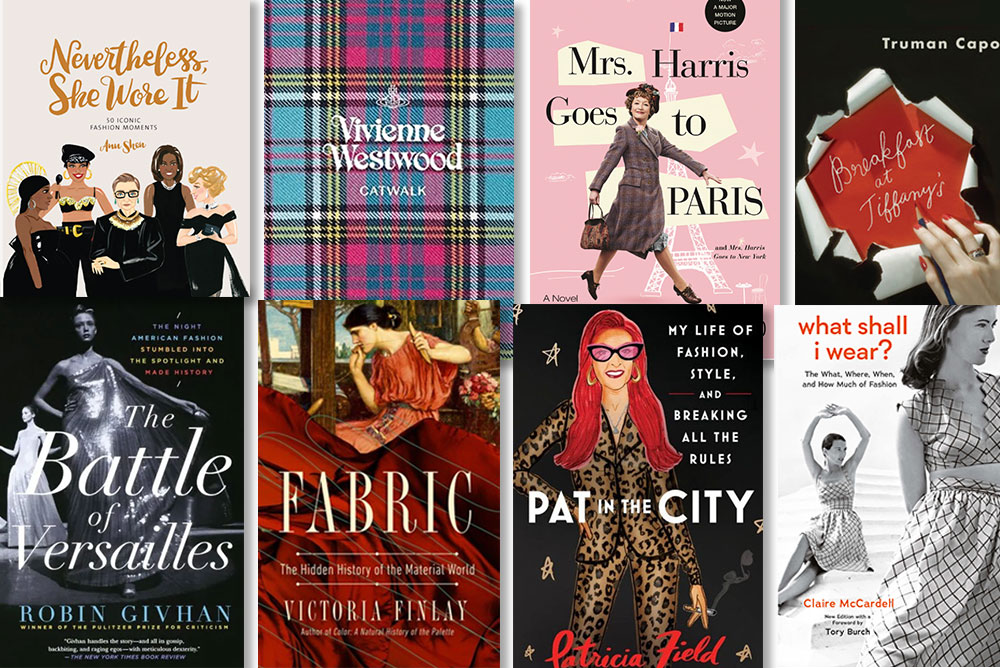
By Janet Kelly
“EVERY single person makes a decision every day about how they’re going to appear in public. Why is this not a major subject?” wonders New Yorker writer Judith Thurman.
We have often wondered the same. Which is one reason we’ve decided to expand our education by reading a bunch of books on our favorite subject. Some we’ve chosen are new, some vintage and/or reissued.
The Queen of Fashion is a fast-moving read about how Marie Antoinette used clothing to carve out her image and why it worked at first but ultimately failed her. As entertaining and educational is The Battle of Versailles, which describes how five American designers and their unstoppable publicist outdid the French fashion establishment.
“The only reason I’m in fashion is to destroy the word ‘conformity,’” said Dame Vivienne Westwood early on in her career. If you’re a Westwood fan, the Catwalk, an overview of 40 years of her womenswear collections, is a must. If not, it’s an opportunity to find out why she’s so special. Designer Claire McCardell’s words on style also reveal her as something of a maverick: “If fashion seems to be saying something that isn’t right for you, ignore it.”
We may not know why what we wear doesn’t seem to matter much. But the ideas and stories of the women who either wrote these books, like McCardell, or are featured in them—like Marie Antoinette—do matter for the ways they moved the needle on fashion.
Below, our reading picks.
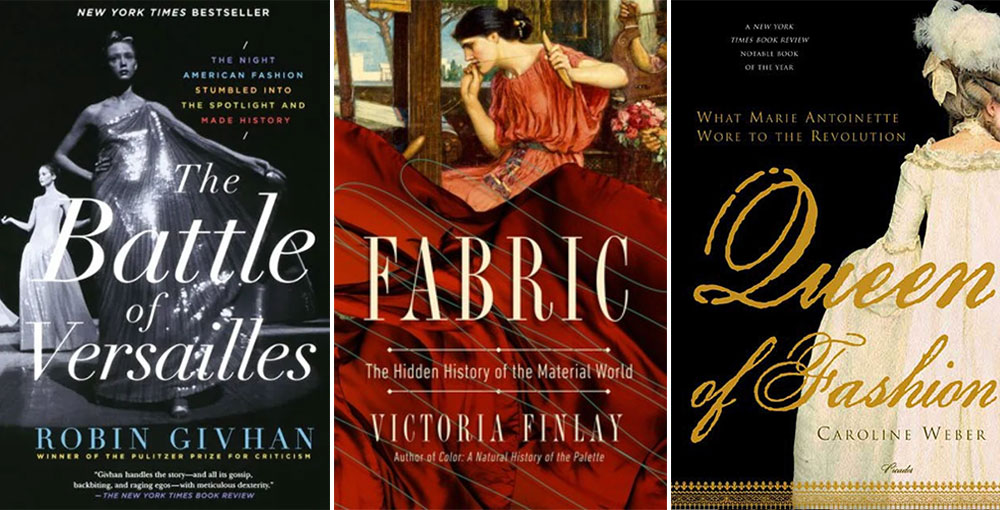
LEFT: Robin Givhan’s very readable lesson in fashion history with a cast of colorful characters, includes Eleanor Lambert, the publicist who conceived the idea of a fashion-show fundraiser to help restore the palace of Versailles, Halston who took his own celebrity so seriously he began referring to himself in the third person and Stephen Burrows, a cool black kid who came out of the ether. The “battle” pitted five French designers (Yves Saint Laurent, Givenchy, Marc Bohan, Ungaro and Pierre Cardin) against Americans Oscar de la Renta, Halston, Anne Klein, Bill Blass and Burrows with the Americans decidedly the underdog. Against all expectations and in difficult working conditions, American energy along with a group of fearless models (ten of whom were African American) won out, resulting in American fashion taking its place on the world stage. For more about The Battle of Versailles: The Night American Fashion Stumbled into the Spotlight and Made History (Flatiron Books), read MyLittleBird’s interview with Givhan.
CENTER: Victoria Finlay’s art memoir/travelogue, Fabric: The Hidden History of the Material World (Pegasus Books), begins in Papua, New Guinea, with barkcloth and ends in Gee’s Bend, Alabama, with the community’s patchwork quilts. For those not versed in the textile arts, skip to the parts that discuss clothing trends, such as Indian pashmina shawls that dominated 19th-century European fashion, the silk dragon robes of China’s Qing dynasty and nylon stockings of 1940s America.
RIGHT: Many people dismiss Marie-Antoinette as a spoiled, selfish girl (she was only 14 when she arrived at the French court from her native Austria). But author Caroline Weber, fashion historian and Barnard College professor, tells a more sympathetic story in Queen of Fashion: What Marie Antoinette Wore to the Revolution (Macmillan). Amid unrelenting pressure to establish herself (made more difficult by her husband’s long reluctance to sleep with her), Marie Antoinette reinvented herself as a fashion icon, wearing three-foot high powdered and ostrich feather-adorned poufs (headdresses) to command attention and attract a following. When a flour shortage (flour was one of the ingredients in the powder for poufs) unleashed a backlash, she retreated to Versailles’ Petit Trianon, where she abandoned poufs (and heavy makeup) for muslin, loose chemise dresses instead of the French court-preferred, elaborate dresses with faint-inducing corsets. She changed the direction of French fashion, but while her “new look” was admired, the tide turned against her for wearing clothes that were not considered splendid enough. Weber argues that the power of fashion did too much and too little to save the head of Marie Antoinette.
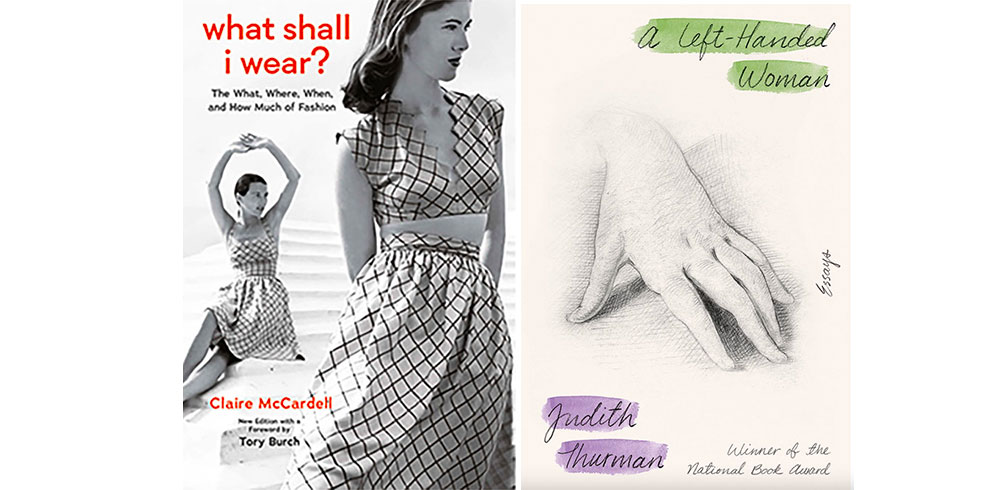
LEFT: Don’t get dressed without reading Claire McCardell’s What Shall I Wear?: The What, Where, When and How Much of Fashion (Harry N. Abrams; updated edition). Originally published in 1956, the book has been reissued in a new edition with a foreword by Tory Burch. McCardell’s modern, accessible ideas included ballet flats, denim for day and pockets in dresses. Take note of her practical suggestions for how to shop, the importance of comfortable shoes and investment dressing. Want to dive deeper? There’s an exhibit on Claire McCardell at the Maryland Center for History and Culture in Baltimore, and it’s open through November, 2023.
RIGHT: In this book of 39 essays, A Left-Handed Woman (Farrar, Straus & Giroux), Thurman, biographer of Colette and Isak Dinesen and New Yorker writer for the past 35 years, profiles fashion designers from Isabel Toledo (who designed the matching coat and dress Michelle Obama wore to her husband’s first inauguration) to the black designer, Ann Lowe, who made the gown Jaqueline Bouvier wore to wed John F. Kennedy. She also weighs in on the likes of Helen Gurley Brown, Emily Dickinson and Dante. As a leftie whose father tried—unsuccessfully—to force her to switch to writing with her right hand, she’s sympathetic to her mostly female, trailblazing subjects.
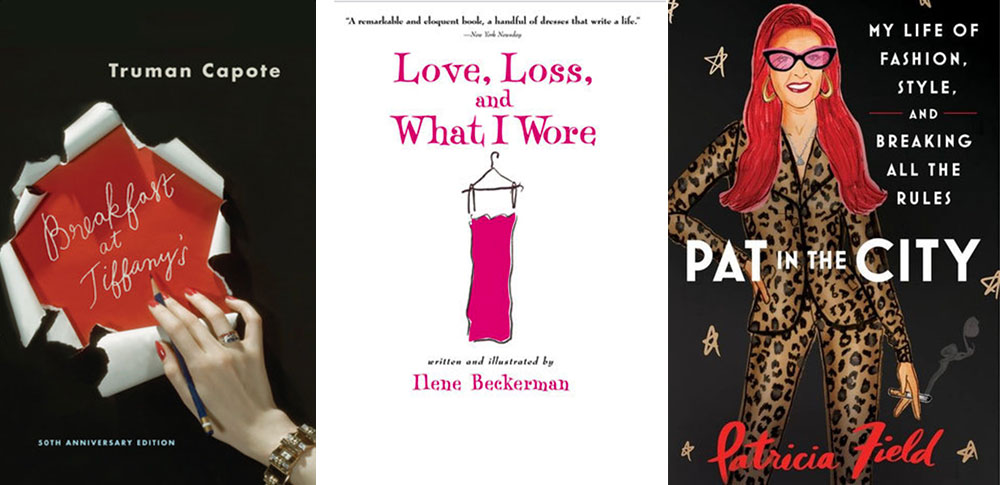 LEFT: Even though it’s almost impossible to separate the 1961 film starring Audrey Hepburn from Truman Capote’s 1958 novella, Breakfast at Tiffany’s (Vintage Books), is worth reading for the pure pleasure of Capote’s prose and the introduction of the little black dress, along with strands of pearls and sunglasses. “It was a warm evening, nearly summer, and she wore a slim cool black dress, black sandals, and a pearl choker. …she had an almost breakfast-cereal air of health, a soap and lemon cleanness …” Sartorial suggestions include: “It’s tacky to wear diamonds before you’re 40, and even that’s risky. They only look right on the really old girls.”
LEFT: Even though it’s almost impossible to separate the 1961 film starring Audrey Hepburn from Truman Capote’s 1958 novella, Breakfast at Tiffany’s (Vintage Books), is worth reading for the pure pleasure of Capote’s prose and the introduction of the little black dress, along with strands of pearls and sunglasses. “It was a warm evening, nearly summer, and she wore a slim cool black dress, black sandals, and a pearl choker. …she had an almost breakfast-cereal air of health, a soap and lemon cleanness …” Sartorial suggestions include: “It’s tacky to wear diamonds before you’re 40, and even that’s risky. They only look right on the really old girls.”
CENTER: Do you recall the fabulous Pucci dress you snagged at Loehmann’s, what you wore the day you became engaged, went to your first prom, filed for divorce? Author Ilene Beckerman believes our memories are often tied to our favorite outfits and chronicles her joys and sorrows from her Brownie uniform to her Diane von Furstenberg wrap dress. Love, Loss and What I Wore (Algonquin Books) is a poignant look at life through the lens of clothing.
RIGHT: Patricia Field opened her eponymous Bowery boutique in 1966, where until 2016 she catered to “starving artists and drag queens,” along with New York University students. But life changed in 1998 when her pal Sarah Jessica Parker convinced Darren Star to let Field take over the job of costume designer on HBO’s upcoming “Sex and the City.” When Field paired a white tulle tutu with a tank top for SJP to wear in the opening title sequence of the new show, the star of this unconventional, opinionated woman shot up. She’s currently 81 and still speaking up— in her new memoir, Pat in the City: My Life of Fashion, Style, and Breaking All the Rules (HarperCollins), written with Rebecca Paley .
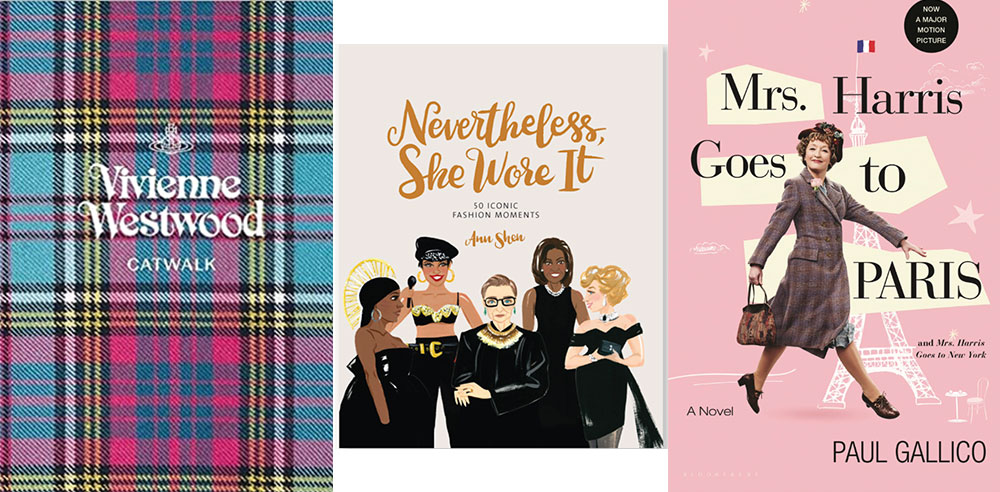
LEFT: In Vivienne Westwood: The Complete Collections (Catwalk) by Alexander Fury (Yale University Press), short texts explain each collection’s highlights and influences, accompanied by runway photographs showing hundreds of clothing ensembles, documenting Westwood’s runway from 1981.
CENTER: From the bikini to the pantsuit, the colorfully illustrated Nevertheless She Wore It: 50 Iconic Fashion Moments by Ann Shen (Chronicle Books) showcases 50 memorable fashions and the women who wore them, along with insightful information behind the sartorial choices that defined their time. Think the Flapper Dress, the 1920s outfit of female independence; the Afro hairstyle, a symbol of black beauty and power; the Cone Bra Madonna wore in 1989’s “Express Yourself”; and the Dissent Collar Ruth Bader Ginsburg put on when she disagreed with the majority.
RIGHT: The 2022 film sparked the re-release of this tale of a London cleaning lady with a heart of gold and unfailing optimism about people. In Mrs. Harris Goes to Paris by Paul Gallico, Ada becomes enchanted by a Dior gown she sees in the closet of one of her wealthy clients. Determined to buy one for herself, she saves for years until she finds herself in the front row at a Dior couture collection in Paris.
MyLittleBird often includes links to products we write about. Our editorial choices are made independently; nonetheless, a purchase made through such a link can sometimes result in MyLittleBird receiving a commission on the sale. We are also an Amazon Associate.

The emergence of female designers was a revolution, a welcomed one. Think I’ll grab one or two of these to enjoy, particularly since I love clothes (even if my wardrobe presently consists of mainly jeans and sweaters). Great column.
Glad you enjoyed. If you like history a bit — you don’t even need to—-Battle of Versailles and Queen of Fashion are fascinating.
Janet
This was a splendid piece! I’ve always suspected fashion was a way for male designers to enslave women in their impractical feminine fantasies. However, the designers who see fashion as a way to break the rules, and in doing so make statements about fearless creativity and originality…wow! I can’t wait to get started on this book list!
Thank you!
Xoxoxo
C
Thanks, Cindy. I was delighted to find and read about so many women in fashion who broke the mold.